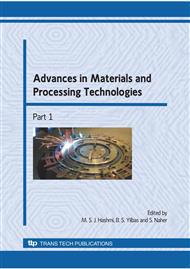p.1
p.7
p.16
p.24
p.31
p.36
p.41
p.49
Development of a Starch-Based Binder in Metal Injection Molding
Abstract:
A new starch-based binder as a natural polymer has been developed for metal injection molding (MIM). In this study tapioca starch which is cheap and readily available in Malaysia has been used as a binder which composed of starch, glycerol, linear low density polyethylene (LLDPE), citric acid and stearic acid. This developed binder system was mixed with 316 L stainless steel powder to prepare the feedstock at three different of powder loadings of 56, 57 and 58% vol. The rheological behavior of the binder and feedstock were evaluated at different temperatures using a capillary rheometer. The rheological behavior of binder shows less than 10 Pa s and the flow behavior index of the feedstocks were determined to less than 1, which indicates the flow characteristic is pseudo-plastic which is suitable for MIM process. Finally, among these three feedstocks, the feedstock of 57% vol. powder loading was selected and its viscosity values within expected shear rate range are less than 1000 Pa s.
Info:
Periodical:
Pages:
24-30
Citation:
Online since:
December 2009
Authors:
Keywords:
Price:
Сopyright:
© 2010 Trans Tech Publications Ltd. All Rights Reserved
Share:
Citation:


